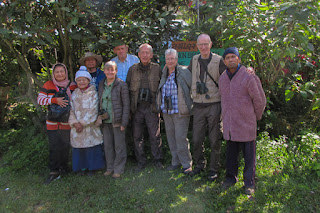We made several visits to the 340-metre long boardwalk trail known as Angkha (or Ang Ka), located near the summit and enjoyed some reasonable birding in spite of the conditions and the many non-birding, sometimes noisy tourists who seemed largely oblivious to the presence of any birds. Highlights here included Dark-sided Thrush, White-browed Shortwing, Yellow-bellied Flowerpecker, Snowy-browed Flycatcher and a brief look at a Grey-sided Thrush.
Ang Ka boardwalk
Yellow-bellied Flowerpecker
Snowy-browed Flycatcher
Across the road from the trailhead, the small café attracted even more tourists but as well as enjoying a warming drink there we also had good views of Blue Whistling Thrush and Bar-throated Minlas among the sea of selfie sticks.
Blue Whistling Thrush
Bar-throated Minla
In spite of the weekend traffic there was some good birding from the side of the main road up the mountain and when the dust and noise of the traffic became too much there were tracks off that provided some relief and some interesting birds. Probably the best of these was the abandoned jeep track at kilometre 37.5 but it was badly overgrown and with numerous fallen trees to climb over it was a bit of an obstacle course. It was badly in need of a work party with a couple of chain saws!
Climbing over fallen trees
Just a short drive up the road from Mr Deang’s, the ‘kilometre 34.5 track’ was another one of the recommended sites on the mountain. After who knows how many days of rain it was horribly muddy but still we went there twice, the second time hoping it would be better than the first! It wasn’t! Birds seen included Asian Emerald Cuckoo and a female Vivid Niltava and we also flushed a couple of Mountain Bamboo Partridges off the track but the conditions were awful and the birds disappointing.
This is why we packed our wellies!
It’s fair to say that we didn't see Doi Inthanon at its best and we were all pleased when it came time to leave! There was at least the expectation that we would be warmer and drier elsewhere. In fact we did see some sun on the last morning there but under a clearer sky it was colder than ever. On the way down the mountain we made two short but worthwhile stops that produced Slaty-backed Forktail, Plumbeous Water Redstart, Collared Falconet, Red-billed Blue Magpie and a couple of picturesque waterfalls.
Our group with Mr Deang
Our next destination was Seng Dao Resort Li from where we made two visits to the nearby Mae Ping National Park. This area of mainly dry dipterocarp forest had been billed as a site where we might find some woodpeckers and we did indeed see Grey-capped Pygmy Woodpecker, White-bellied Woodpecker, Greater & Common Yellownapes, Common Flameback and several groups of striking Black-headed Woodpeckers. In addition Blossom-headed & Grey-headed Parakeets, Common & Large Woodshrikes, Rosy Minivet, Black-naped & Black-hooded Orioles, Rufous Treepie and Violet Cuckoo were among the highlights. We did a lot of walking but we got our reward. Better weather and plenty of birds were just what we needed!
Common Flameback
Black-naped Oriole
Violet Cuckoo
From Mae Ping it was a long drive to Nakhon Sawan, a journey punctuated by a diversion to the Bhumibol Dam on the Ping River to see Dusky Crag Martins. It was a chance for some to catch up on their sleep, for others to simply look forward to another night in a comfortable bed – we were heading to MaiHom Resort, a hotel that we had stayed at last year. In fact much of the rest of the trip was a repeat of last year’s itinerary.
More to follow...


























































